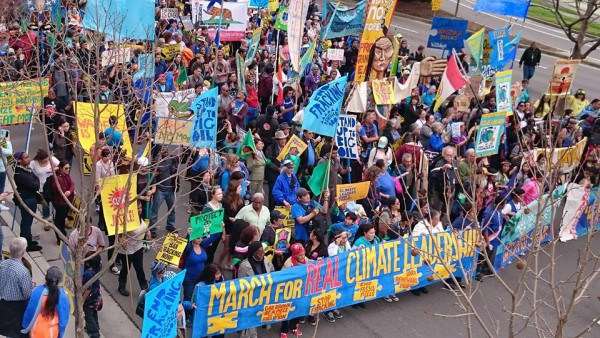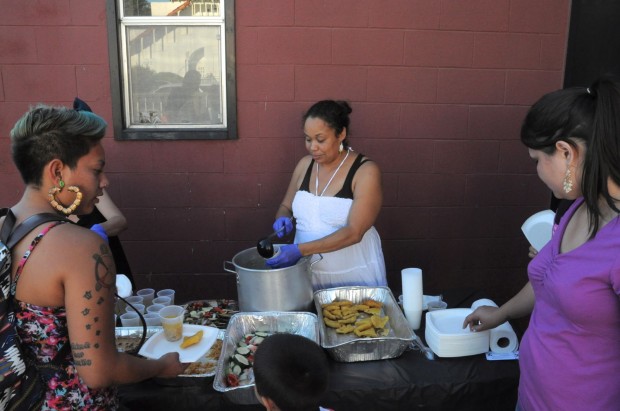Largest Anti-Fracking Rally in United States history

By Nanette Bradley Deetz, Native News Online
OAKLAND, CALIFORNIA — On Saturday, February 7, eight thousand Californians marched in the largest anti-fracking demonstration in US history. The “March for Real Climate Leadership” was held in downtown Oakland, Gov. Jerry Brown’s home city, in order to focus on the need for Brown to end fracking.”We’re here, marching in Jerry Brown’s hometown, to let him know climate leaders don’t frack,” said Linda Caputo, fracking coordinator for 350.org, an international organization that fights climate change.
The marchers assembled in front of City Hall in downtown Oakland, then traveled nearly two miles to the Lake Merritt Amphitheater where a rally was held. Various marchers held signs proclaiming “Idle No More,” “Our Oceans Are Rising, so we Rise Up,” ” No Keystone Pipeline,” “Save the Delta,” “Save Mother Earth,” among many others.
DESPITE RAIN AND WIND, THE MARCH WOUND ITS WAY THROUGH DOWNTOWN OAKLAND WHILE NATIVE WOMEN SANG THE “WOMEN’S WARRIOR SONG.”
Nanette Bradley Detz & Pennie Opal Plant – Photo Credit: Steve Storm.
Pacific Islanders sang traditional songs, along with many marchers drumming, singing, and sending a peaceful yet powerful message to Gov. Jerry Brown.
The march was organized by a large coalition of environmental organizations composed of the Indigenous Block to end fracking that included SF Idle No More, led by Pennie Opal Plant, Marshall Islanders, various California tribes, including Ohlone leader, Corrina Gould, Los Angeles Chapter of AIM, AIM West of Northern California, and many Native Americans from the Bay Area and other parts of California. The Indigenous Block led the march. Other organizations included labor unions, local environment justice groups such as 350.org ,Food and Water Watch, national NGO’s, various health activists, community activists, students, and those committed to protecting water and air for generations to come.
“Fracking is hurting our communities. It is sucking our drought ridden state of precious water resources, contaminating our groundwater in a region where 25% of the nation’s food is grown, and contributing to the impending climate crisis. Oil companies have made Californians feel powerless and silenced, because our governor is only listening to their money,” UC Berkeley student Eva Malis said.
Photo Credit: Charles Lopez
Contingents of marchers traveled from San Diego, Los Angeles, Fresno, and the central coast of California. The rally at Lake Merritt amphitheater began with a traditional Pacific Island chant, then a prayer by Bay area Marshall Island community leader Abon-Burch. Fuifuilupe Niumeitolu then introduced a group of Marshall Island youth who sang traditional songs about water and love for their Moana. Dianne Thomas, a community organizer from Carson, California reported that in 2011 Occidental Oil Company wanted to re-open old oil wells and build 200 new wells over a period of ten years.
“As a community, we continued to organize and fight Occidental Oil, even though we only had the support of one council member in our favor. The draft EIR report never got out of the response phase, and eventually Occidental Oil pulled out of Carson. When we all work together, we can prevail,” said Thomas.
On Monday, February 8, organizers of the anti-fracking march and rally will present Gov. Jerry Brown with 200,000 signatures demanding an end to fracking throughout California.




